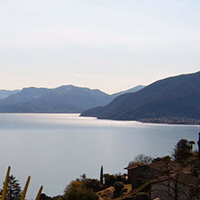Automated high frequency monitoring of Lake Maggiore through in situ sensors: system design, field test and data quality control

Accepted: 19 April 2021
HTML: 25
All claims expressed in this article are solely those of the authors and do not necessarily represent those of their affiliated organizations, or those of the publisher, the editors and the reviewers. Any product that may be evaluated in this article or claim that may be made by its manufacturer is not guaranteed or endorsed by the publisher.
Authors
A high frequency monitoring (HFM) system for the deep subalpine lakes Maggiore, Lugano and Como is under development within the EU INTERREG project SIMILE. The HFM system is designed to i) describe often neglected but potentially relevant processes occurring on short time scale; ii) become a cost-effective source of environmental data; and iii) strengthen the coordinated management of water resources in the subalpine lake district. In this project framework, a first HFM station (LM1) consisting of a monitoring buoy was placed in Lake Maggiore. LM1 represents a pilot experience within the project, aimed at providing the practical know-how needed for the development of the whole HFM system. To increase replicability and transferability, LM1 was developed in-house, and conceived as a low-cost modular system. LM1 is presently equipped with solar panels, a weather station, and sensors for water temperature, pH, dissolved oxygen, conductivity, and chlorophyll-a. In this study, we describe the main features of LM1 (hardware and software) and the adopted Quality Assurance/Quality Control (QA/QC) procedures. To this end, we provide examples from a test period, i.e., the first 9-months of functioning of LM1. A description of the software selected as data management software for the HFM system (IstSOS) is also provided. Data gathered during the study period provided clear evidence that coupling HFM and discrete sampling for QA/QC controls is necessary to produce accurate data and to detect and correct errors, mainly because of sensor fouling and calibration drift. These results also provide essential information to develop further the HFM system and shared protocols adapted to the local environmental (i.e., large subalpine lakes) and technical (expertise availability) context. Next challenge is making HFM not only a source of previously unaffordable information, but also a cost-effective tool for environmental monitoring.
Edited by
Diego Fontaneto, CNR-IRSA Water Research Institute, Verbania, ItalyDepartment of Earth and Environmental Sciences (DSTA), University of Pavia, Italy
How to Cite

This work is licensed under a Creative Commons Attribution-NonCommercial 4.0 International License.
Similar Articles
- Stefanie VON FUMETTI, Peter NAGEL, A first approach to a faunistic crenon typology based on functional feeding groups , Journal of Limnology: Vol. 70 No. s1 (2011): Springs: neglected key habitats for biodiversity conservation
- Roberto Bertoni, Journal of Limnology: of ancestors and descendants , Journal of Limnology: Vol. 75 No. 2 (2016)
- Maria Chiara FONTANELLA, Oscar RAVERA, Gian Maria BEONE, Nicoletta RICCARDI, Ilenia CATTANI, Mercury distribution in the main compartments of the eutrophic Lake Candia (Northern Italy) , Journal of Limnology: Vol. 68 No. 2 (2009)
- Anna VISCONTI, Marina MANCA, Riccardo DE BERNARDI, Eutrophication-like response to climate warming: an analysis of Lago Maggiore (N. Italy) zooplankton in contrasting years , Journal of Limnology: Vol. 67 No. 2 (2008)
- Nikolai M. KOROVCHINSKY, New species of Holopedium Zaddach, 1855 (Crustacea: Cladocera: Ctenopoda) from Greenland , Journal of Limnology: Vol. 64 No. 2 (2005)
- Jens Petter NILSSEN, Svein Birger WÆRVÅGEN, Superficial ecosystem similarities vs autecological stripping: the "twin species" Mesocyclops leuckarti (Claus) and Thermocyclops oithonoides (Sars) - seasonal habitat utilisation and life history traits , Journal of Limnology: Vol. 59 No. 2 (2000)
- Rosario MOSELLO, Aldo MARCHETTO, Maria C. BRIZZIO, Michela ROGORA, Gabriele A. TARTARI, Results from the Italian participation in the International Co-operative Programme on Assessment and Monitoring of Acidification of Rivers and Lakes (ICP Waters) , Journal of Limnology: Vol. 59 No. 1 (2000)
- Juri NASCIMBENE, Daniel SPITALE, Holger THÜS, Marco CANTONATI, Congruencies between photoautotrophic groups in springs of the Italian Alps: implications for conservation strategies , Journal of Limnology: Vol. 70 No. s1 (2011): Springs: neglected key habitats for biodiversity conservation
- Anna VISCONTI, Marina MANCA, The invasive appearance of Eudiaptomus gracilis (G.O. Sars 1863) in Lago Maggiore , Journal of Limnology: Vol. 69 No. 2 (2010)
- Marina MANCA, Fiorenza G. MARGARITORA, Unusual median pores of Alona head shields recovered from recent and pre-industrial sediments of Alpine lakes , Journal of Limnology: Vol. 67 No. 1 (2008)
<< < 79 80 81 82 83 84 85 86 87 88 > >>
You may also start an advanced similarity search for this article.
-
Marzia Ciampittiello, Dario Manca, Claudia Dresti, Stefano Grisoni, Andrea Lami, Helmi SaidiSensors : 2021
-
Dyah P. Djenal, Santoso Soekirno, Prada Wellyantama, Aly Ilyas, Sugiarto, Maulana PutraAdvances in Physics Research : 2023
-
Carlo Andrea Biraghi, Daniela Carrion, Maria Antonia BrovelliSustainability : 2022
-
Mikhail Makarov, Ilya Aslamov, Ruslan GnatovskySensors : 2021
-
Andrea Fenocchi, Fabio Buzzi, Claudia Dresti, Diego CopettiEcological Indicators : 2023
-
Yuli Sudriani, Viktor Sebestyén, János AbonyiIEEE Access : 2023
-
Milad Niroumand-Jadidi, Francesca Bovolo, Mariano Bresciani, Peter Gege, Claudia GiardinoRemote Sensing : 2022
-
Jacquelyn Q. Schmidt, Branko KerkezEnvironmental Science & Technology : 2023
-
Claudia Dresti, Andrea Fenocchi, Diego CopettiJournal of Limnology : 2021
-
S. Piccolroaz, S. Zhu, R. Ladwig, L. Carrea, S. Oliver, A. P. Piotrowski, M. Ptak, R. Shinohara, M. Sojka, R. I. Woolway, D. Z. ZhuReviews of Geophysics : 2024
-
Michela Rogora, Tommaso Cancellario, Rossana Caroni, Lyudmila Kamburska, Dario Manca, Simona Musazzi, Rocco Tiberti, Andrea LamiFrontiers in Environmental Science : 2023

 https://doi.org/10.4081/jlimnol.2021.2011
https://doi.org/10.4081/jlimnol.2021.2011





